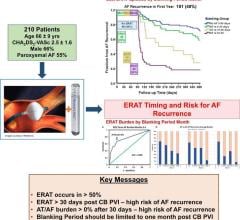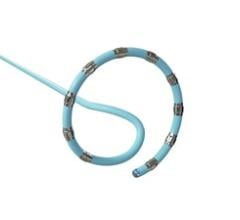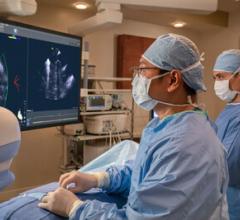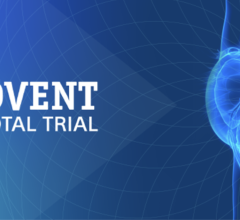
When performing radiofrequency (RF) ablation to treat cardiac arrhythmia, medical professionals must balance the safety of the patient with the efficacy of the procedure. Several important safety considerations are at play.
Physicians want to avoid mechanical perforation of the cardiac tissue, which can be caused by applying too much force in positioning the catheter. They also want to avoid unintentional damage to tissue or nontargeted structures during RF delivery.
Among the rare but serious complications associated with RF ablation are “steam pops,” which occur when ablated tissue is heated above 100° C, causing an explosion of steam to be released and unwanted damage to the tissue. In a worst-case scenario, a steam pop can tear a hole in the wall of the cardiac tissue allowing blood to leak into the pericardium. This can lead to cardiac tamponade, when the pressure from the blood surrounding the heart prevents it from beating.
Advances in RF
Since the introduction of RF ablation as a cardiac arrhythmia therapy, advances have been made in the technologies and methods of delivering RF. These include the introduction of advanced mapping, multi-electrode and irrigated catheters, contact force, and the use of measures of tissue resistivity, or impedance, as a means to track RF delivery and lesion development.1
Boston Scientific offers RF ablation catheters with technology that enables capture of impedance metrics nearer the tissue to be treated. With the DIRECTSENSE™ Technology-enabled catheters, impedance can be measured around the tip of the catheter, avoiding the interference of far-field signals and capturing insights on cardiac tissue resistivity.
Local impedance has been demonstrated to more accurately indicate subsurface tissue temperature and lesion formation than does surface temperature. In tissue tests with embedded thermocouples, local impedance drop followed the rate and magnitude of the rise in intra-lesion temperature, demonstrating a correlation between the metric and volumetric heating as it occurs.2 Local impedance has also been found to respond with greater specificity and sensitivity in identifying abnormal substrate — all valuable feedback in helping inform optimal delivery of ablation therapy.
Contact Force with Deeper Insights
Boston Scientific has now incorporated contact force capabilities into their DIRECTSENSE-enabled ablation catheters.
The INTELLANAV STABLEPOINT™ Ablation Catheter brings together the handling and inputs of contact force catheters with the ablation feedback offered by DIRECTSENSE local impedance. The STABLEPOINT catheter is designed to help physicians verify contact, discern tissue characteristics, monitor subsurface tissue heating for predictable and controlled delivery of RF.
With the addition of force technology, the STABLEPOINT catheter can help confirm tissue contact and catheter-tip stability for the duration of RF delivery. In one study, force readings enabled two independent users to maintain a stable average force of +/- 5 grams, compared to starting force, for the full duration of >90 percent of point-by-point PVI applications.3
Using local impedance, physicians gain insights into tissue characteristics and resistivity, input that can help guide the ablation strategy. Changes in local impedance during ablation offer information on lesion development and feedback that can help safeguard against tissue overheating.
Clinical Findings into the Novel RF Catheter
Recent studies have examined the STABLEPOINT catheter’s use in clinical settings. In a multicenter, prospective study conducted across Europe, Asia, and the United States, 299 patients treated for de novo atrial fibrillation (AF) underwent pulmonary vein isolation with the STABLEPOINT catheter guided by RHYTHMIA HDx Mapping System. STABLEPOINT in the NEwTON AF Study met the 30-day and 12-month primary safety endpoints as well as the acute, 6-month and 12-month primary effectiveness performance criteria for the use of the catheter in this patient population.4 At 12 months, data indicated a 4 percent incidence of adverse events. Freedom from atrial flutter and atrial tachycardia in the study group was 90.2 and 97.6 percent, respectively.4
A separate, multicenter study of 212 consecutive patients treated for AF with the STABLEPOINT catheter assessed results across 13,891 RF applications of a ≥3 second duration. High-power, short-duration ablation with contact force and local impedance resulted in a 93.3 percent rate of successful first-pass isolation with no reported steam pops or major complications. Researchers also noted that the combination of local impedance drop with good contact led to a reduction in the duration of RF.5
Editor's note: This is the conclusion of a three-part series on cardiac ablation technology. Part one, Pulsed Field Ablation: A New Ablation Method, addressed pulsed field ablation; Part two, Cryoablation Gets New Tech," covers next-generation cryoballoon technology.
References
1. Habibi M, Berger RD, Calkins, H. Radiofrequency ablation: technological trends, challenges, and opportunities. EP Europace. 2021;23(4): 511–519. doi.org/10.1093/europace/euaa328
2. Garrott KE, et al. Intra-lesion temperature rise and local impedance drop predictive of lesion growth on RF ablation catheter with mini electrodes. Abstract. Heart Rhythm Annual Meeting. May 2020.
3. Internal BSC Report 92464384.
4. NEwTON AF: Clinical Evaluation of the STABLEPOINTTM Catheter and Force Sensing System for Paroxysmal Atrial Fibrillation. NEwTON AF Study (NCT04580914) presented at AHA, November 2023.
5. Lepillier A, Maggio R, De Sanctis V, et al. Insight into contact force local impedance technology for predicting effective pulmonary vein isolation. Front Cardiovasc Med. 2023;10. doi.org/10.3389/fcvm.2023.1169037
Click here for INTELLNAV STABLEPOINT™ Ablation Catheter indications, safety & warnings
©2023 Boston Scientific Corporation or its affiliates.
All rights reserved. All trademarks are the property of their respective owners.
EP-1755903-AA



 April 18, 2024
April 18, 2024 








